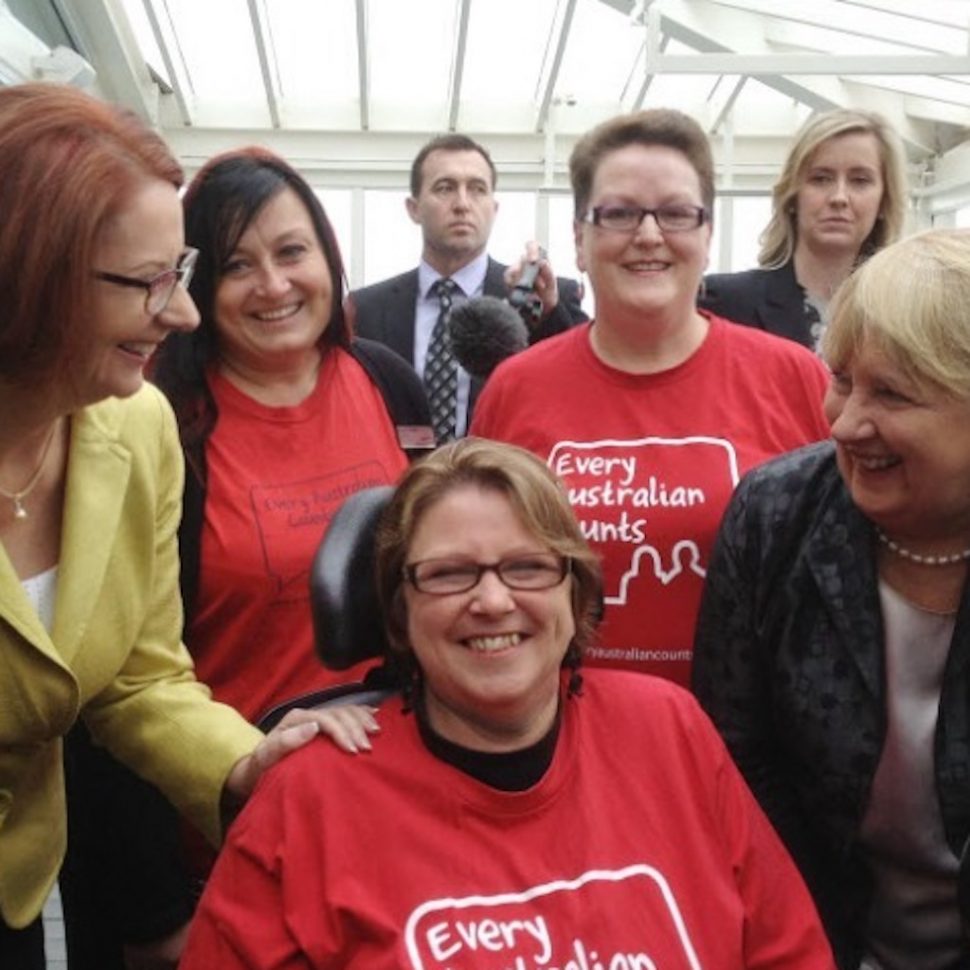Explainer: What were the original intentions of the National Disability Insurance Scheme?

One of the things people with disability and families have been asking their federal election candidates to reflect on this year is a promise to bring the NDIS back on track with it’s original intentions. To look at why we all fought so hard for the NDIS in the first place. What were the ideas, intentions and principles behind the idea for an NDIS? Our friends from PIAC have written a new helpful explainer…
In 2009, the Productivity Commission considered how to fund a national long-term disability care and support scheme. From the inquiry, the National Disability Insurance Scheme (NDIS) was born.
This Explainer considers the Productivity Commission’s original vision and design for the NDIS.
Who was the NDIS for?
The NDIS was intended to bring specialist disability services under a single umbrella, moving away from the previous fragmented and ineffective disability system.
The NDIS was intended to serve three communities:
- For every Australian (Tier 1): the NDIS would provide insurance against the costs of support in the event of acquiring a significant disability.
- For all people with disability and their carers (Tier 2): the NDIS would provide information about care and support options for disabilities and service providers, and referrals to services for which the NDIS was not directly responsible: ie mainstream services and community groups. The goal was to promote community engagement and employment for people with disabilities.
- For people with significant and long-term disabilities (Tier 3): following an assessment process, the NDIS would provide individually tailored supports. This third function would account for most of the costs of the NDIS.
What principles frame the NDIS?
The main principles underpinning the NDIS were:
- Promoting the participation and inclusion of people with disability in the community: to improve the wellbeing of people with disability and their carers and reduce the longer-term costs of care and support.
- Engaging the community: to raise awareness and change attitudes about disability, and support the participation of people with disability in community activities. This brings benefits to the whole community.
- Giving ‘choice and control’ to people with disability: to enhance wellbeing, independence and social and economic participation. People with disability are better placed to know what they need, and decision-making power should be given to them, rather than government and service providers.
- Certainty of lifelong support: to provide a certain and sufficient source of future funding for proper life planning for people with disability.
- Greater sustainability: to build a sustainable and efficient scheme through strong governance.
The NDIS is designed as a social insurance model.
This approach reflects that disability arises socially rather than medically and guarantees services to insure people against long-term or ongoing risks.
The NDIS is also part of Australia’s efforts to meet our international human rights obligations, including under the United Nations Convention on the Rights of Persons with Disabilities. This includes the rights of people with disability to access the community, live independently, participate fully in all aspects of life and to have choices equal to others.
Eligibility and assessment to access the NDIS
The NDIS was intended to provide funding determined by need, rather than an arbitrary amount.
For people with significant and long-term disabilities (tier 3 participants), criteria for eligibility would assess a person’s disability and functional capacity (ie their ability to do things, including social activities).
The Productivity Commission recommended that assessment tools be developed to determine the level of needs and funding, with safeguards to ensure the fair use of assessment tools and protect sustainability:
- objective assessments should be conducted by an allied health professional drawing upon existing medical reports and collaborating with the person with disability and their ‘circle of support’ (ie family, carers and direct support professionals);
- supports should be ‘reasonable and necessary’ (see further below).
Early intervention
Early intervention was seen as critical to the effective operation of the scheme – investing resources in the early stages of a person’s disability to improve their functioning or reduce the supports they need later, minimising costs over the long-term.
It was intended that many early interventions to reduce the risk of disability would continue to be under the control of agencies outside the NDIS, such as health, education, child protection, housing and criminal justice services. The NDIS was not seen as being the primary funder or coordinator of such interventions.
Yet, given the goal of early intervention, the Productivity Commission considered it a priority for the NDIA to establish an evidence base of economic analyses of early interventions to assess value for money. An established evidence base could lead to the development of guidelines to assist the NDIA in deciding whether people with disability obtain early intervention support under tier 3.
Funding specialist disability support
The NDIS was intended to fund specialist disability supports. These are supports that would otherwise not be reasonably met without NDIS funding, or that are not more appropriately met by other services. The NDIS was not intended to respond to shortfalls in mainstream government-funded services such as education, health care, public housing, transport and employment services.
To determine whether a support was ‘reasonable and necessary’, the Productivity Commission recommended the NDIS adopt guidelines considering:
- the benefit of the support to the participant;
- appropriateness of the support and service (ie in line with current clinical practice);
- appropriateness of the provider (ie qualification and registration of the provider);
- cost-effectiveness having regard to the short and long-term benefits of the service;
- whether the support or service would be most appropriately provided through the NDIS.
Disability within First Nations communities
From its beginnings, the Scheme recognised that First Nations people with disability experienced particular barriers to accessing disability services. To improve accessibility and delivery of disability services to First Nations people, the Productivity Commission suggested embedding services within the community, employing First Nations staff and improving services through cultural awareness training.
Financial sustainability
The Financial sustainability of the NDIS was considered at the outset, and was guided by the following principles and parameters:
- The NDIS was intended to supplement, not replace, existing income support programs such as the Disability Support Pension.
- The NDIS should focus on cost-effective early interventions, to increase economic participation by people with disability and their carers and minimise costs over the long-term.
- The benefits of the NDIS would significantly exceed the costs. Benefits include improved outcomes and economic participation for NDIS participants and carers, efficiency gains in the disability system and savings to other government services.
- Financial sustainability is an obligation of the NDIA board, management and the Minister, requiring gathering and analysing data of financial pressures and risks.
- The Australian Government should be the single funder of the NDIS, as this would be more efficient than coordinating funding from eight different governments and provide greater certainty of long-term funding. (Contrary to the Productivity Commission’s recommendation, each of the Commonwealth, State and Territory governments contribute funding to the NDIS).
More information
A more detailed examination of the intentions behind the NDIS and the Productivity Commission’s reports is available in our Background paper (available as a PDF or Word doc.)
PIAC works with disability rights organisations to make the NDIS fairer and to improve outcomes. Informed by the lived experience of people with disability and the priorities of our partners in the disability sector, we are focused on policy and law reform to improve decision-making by the NDIA, increase transparency and accountability. More information about our work is available here.
We want to give a big thank you to Erin and everyone at the Public Interest Advocacy Centre (PIAC) for allowing us to republish this explainer, which first appeared on the PIAC website here.


Join the conversation